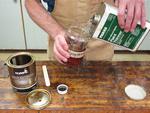We may receive a commission when you use our affiliate links. However, this does not impact our recommendations.
Editor’s note: I’m been planning a kitchen remodel, so I’ve been pouring over all of the resources I can on building kitchen cabinets. Steve Maxwell’s Building Traditional Face Frame Cabinets has some of the best no-nonsense advice and designs I’ve come across, and the included videos are very helpful in explaining the entire process in a clear, hands-on way.
Before you make sawdust, you need to understand how the various parts of this kitchen are built. Get to know the design approach first and success will come more easily.
Foundation Boxes: The inner part of both the upper and lower cabinets are the foundation boxes, and they’re made of 3/4″-thick Baltic Birch ply or cabinet-grade veneered plywood, butt-joined at corners with ordinary wood glue and 2″ finishing nails. Solid wood elements surround these boxes. Simple as it is, these butt-joined boxes are more than strong enough to do the job. The joints don’t look fancy, but they’re completely hidden in the finished cabinets by solid wood face frames, end panels, crown molding and light valances. You could use 1/4″ plywood and solid wood anchor strips for the backs of these foundation boxes, but 1/2″-thick plywood offers an advantage you need to know about. When it comes time to mount your cabinets on a wall, you can drive screws anywhere you like through the thick back and into underlying walls studs. If you opt for 1/4″-thick ply, install horizontal anchor strips of solid wood into the top and bottom of the foundation boxes, as shown in the plans. Strips like these are the traditional anchoring surfaces for fastening cabinets to walls during installation.
Either way – thick back panel or thin – there’s no need to set the back panels into grooves in the sides. Simply fasten the back panels to the back edge of the cabinet with edges exposed. Like I said, later on everything gets covered with solid wood anyway, so plywood edges get hidden. Both upper and lower cabinets are made full length in one piece, 8 to 10 feet long. Longer runs of cabinets can be made by installing more cabinet modules side by side.
The plans show how typical measurements for upper cabinets are 13″ deep x 36″ tall. Lower cabinets measure 23″ deep x 361/2″ tall including the kick base and countertop. at said, these numbers are just start- ing points, so go ahead and adjust sizes to match your kitchen space. Taller, shorter, narrower, deeper – it’s all up to you. More on this later.
Face Frames: The plans show how 3/4″-thick solid wood, 21/4″ to 21/2″ wide, is used for most face frame members. Individual face frame members fasten to the foundation boxes one piece at a time, held in place with glue and clamps or glue and metal pins or brads. e joints between stiles and rails get rein- forced with #20 biscuits or dowels plunged into the assembled joints from the top, before sawing o the excess biscuits or dowels and sanding the joints flush. I’ll explain more about this later.
Doors and End Panels: Solid wood stiles and rails surround shop-cut solid wood panels housed in 5/16″-wide x 1/2″- deep grooves. Joints between stiles and rails are held together with floating hardwood tenons that fit into the same grooves the panels do. This is a technique you may have never seen before, but it’s simple and makes sense. You’ll see later. Note how the back edges of the back stiles need to extend 1/4″ to 1/2″ beyond the back panel to allow for scribing to fit wall irregularities.
Learn more about building kitchen cabinets with this interactive PDF and video course over at Shop Woodworking.
Here are some supplies and tools we find essential in our everyday work around the shop. We may receive a commission from sales referred by our links; however, we have carefully selected these products for their usefulness and quality.














Link is broken and the images don’t load… I came to this from your front page. ?